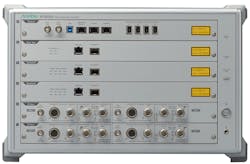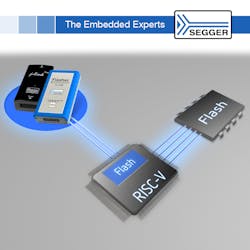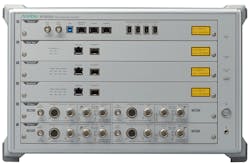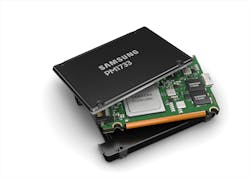Featured Tech - Hot Products from 2021
Featured Tech – November-December – Hot Products from 2021
SEGGER recently released its new Open Flashloader that allows engineers to program any RISC-V system, which fits into just 2 kB of RAM. This provides J-Link debug probes the ability to download directly and into the flash memory of RISC-V microcontrollers or SoCs. It also provides a solution for mass production programming using the Flasher series of programmers. The Open Flashloader works with any software supporting J-Link, including simple command-line programs such as J-Link Commander, GDB or SEGGER's Ozone debuggers, production-oriented utilities such as JFlash, and development tools such as Embedded Studio. Segger
Anritsu’s MT8000A radio communication test station now has 5G protocol test functions, using NR (New Radio) fading software supporting 3GPP TS 38.521-4 B.1/B.2 V15.0.0-compliant 5G NR channel (TDL) model tests. The test station features an integrated internal fader that can support either 2CC 4x4 MIMO tests with one unit or 8CC 2x2 MIMO tests with a pair of units. The MT8000A can cover critical frequency, such as the Sub-6 GHz band (FR1) frequencies of 2.5 GHz, 3.5 GHz, and 4.5 GHz, and the mmWave band (FR2) frequencies of 28 GHz and 39 GHz. Anritsu
The R&S NGA100 is available in four models, each providing a choice of single or dual outputs at up to 35 V / 6 A (100 V / 2 A) per output. Single-output models supply up to 40 W, and dual-output models up to 80 W of power. The dual-output models can be combined to provide up to 200 V or 12 A. Rohde & Schwarz has implemented a linear design throughout the output circuits of the R&S NGA100 to significantly improve performance compared to the switched-mode circuits frequently found in basic power supplies. Rohde & Schwarz
Keysight has announced a new version of its Nemo Handy handheld measurement software aimed at Android-based commercial off-the-shelf (COTS) smartphones for verification of 5G new radio (NR) quality-of-service (QoS) and quality-of-experience (QoE) in the field. The Nemo Handy platform now includes a plug-and-play setup when switching from one 5G COTS smartphone to another. It also features extended measurement functionality with voice quality testing across different 5G devices and support for up to two devices via Keysight's new Nemo Diagnostics Module and chipset diagnostic software for comparable measurements between different vendors. Keysight
Multi-Channel Antenna Brings 4G LTE to the IoT
Novocomms has announced the launch of its FPCB LTE 4G multichannel antenna designed for the Internet of Things. The LTE 4G Bands Flexible PCB features a customizable cable and can be adapted to respond to LB, MB or HB bands. All antennae are designed with 50Ω impedance, and are all available with a customizable coaxial cable. The FPCB LTE 4G antenna is well-suited for medical and wearable devices, and is designed to enable transmission and reception across 4G, Wi-Fi, Bluetooth, and satellite frequencies. Novocomms
MicroMax has designed a ruggedized computer with data acquisition for harsh environments. The M-Max VI-PR7 packs an Intel E3845 (or E3826) quad-core processor, with up to 4 Gb of RAM, an Intel HD Graphics integrated controller and up to 1 Tb of SSD storage. The computer also features a pair of 10/100/1000 Base-T ports, 2X RS-232, and 2X USB 2.0 ports. The M-Max VI-PR7 complies with MIL-STD-810G, MIL-STD461F and MIL-STD-704F specifications, as well as IP66 rated for dust and moisture. The computer can handle vibration up to 2.5G, and is shock-rated for 40G. MicroMax
NXP Semiconductor recently announced that its Wi-Fi and Wi-Fi/Bluetooth combos and i.MX RT MCU crossover processors are now supported within its MCUXpresso software, which simplifies product development. With this latest integration level, the company has expanded the connectivity capabilities of its EdgeVerse edge computing and security platform. By integrating driver support within the MCUXpresso SDK, NXP developers gain flexible and scalable solutions to help speed up compliance, shorten time to market, and streamline Wi-Fi or Wi-Fi/Bluetooth combo deployments. The pre-integrated Wi-Fi/Bluetooth drivers have been verified and tested. NXP provides several examples, including using the iPerf utility to test device-to-device performance, Wi-Fi Direct to scan and connect mobile devices to networks. They’ve also tasked it for use case development for IoT, industrial, automotive and communication infrastructure applications, and more. NXP Semiconductor
Samsung Electronics has announced that it has brought the latest software innovations to its PCIe Gen4 solid-state drive (SSD) series for maximized storage performance using key software technologies. The latest software innovations include fail-in-place (FIP) technology that allows the SSD to keep functioning even when errors occur, virtualization technology that provides independent virtual workspaces that can be subdivided (up to 64 smaller SSDs) for multiple users, and V-NAND machine learning technology, which utilizes big data to verify cell characteristics even when operating at ultra-high speeds. The three software innovations are included with Samsung's latest PCIe Gen 4 SSDs and NVMes.








